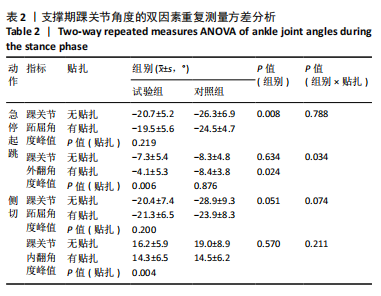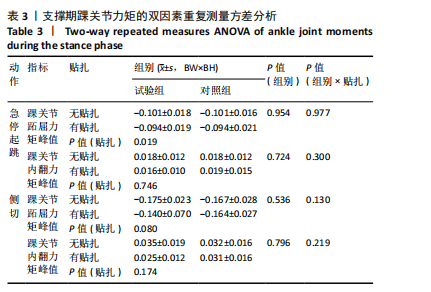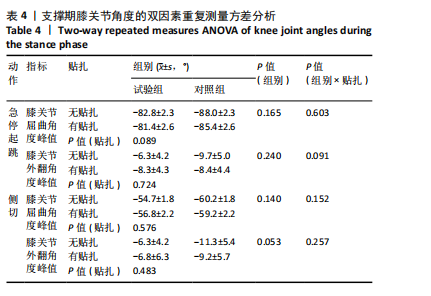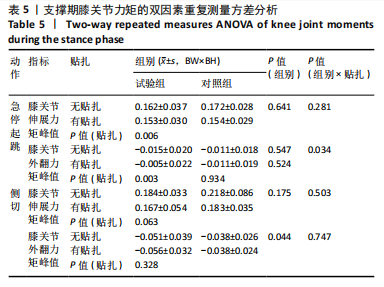[1] MCKAY GD, GOLDIE PA, PAYNE WR, et al. Ankle injuries in basketball: injury rate and risk factors. Br J Sports Med. 2001;35(2):103-108.
[2] 张泽毅, 刘卉, 张美珍, 等. FAI和Coper患者踝关节扭伤相关动作中的下肢运动生物力学特征[J]. 中国体育科技,2023,59(8):47-55.
[3] SARCON AK, HEYRANI N, GIZA E, et al. Lateral Ankle Sprain and Chronic Ankle Instability. Foot Ankle Orthop. 2019;4(2):1-10.
[4] 文子良, 郑兵, 朱江, 等. 慢性踝关节不稳的康复功能评定研究进展[J]. 中国康复医学杂志,2023,38(6):845-850.
[5] 章丽莉,杨玉珊.慢性踝关节不稳姿势稳定性的研究进展[J]. 中国康复理论与实践,2019,25(8):908-912.
[6] 王颉, 周游. 踝关节扭伤模型及相关危险因素研究进展[J]. 中国运动医学杂志,2024,43(2):142-148.
[7] DOHERTY C, BLEAKLEY C, DELAHUNT E, et al. Treatment and prevention of acute and recurrent ankle sprain: an overview of systematic reviews with meta-analysis. Br J Sports Med. 2017;51(2):113-125.
[8] PELLOW JE, BRANTINGHAM JW. The efficacy of adjusting the ankle in the treatment of subacute and chronic grade I and grade II ankle inversion sprains. J Manipulative Physiol Ther. 2001;24(1):17-24.
[9] TANG Y, LIANG P, PAN J, et al. Effects of Ankle Orthoses, Taping, and Insoles on Postural Stability of Individuals with Chronic Ankle Instability: A Systematic Review. Healthcare (Basel). 2023;11(18):570.
[10] DIZON JMR, REYES JJB. A systematic review on the effectiveness of external ankle supports in the prevention of inversion ankle sprains among elite and recreational players. J Sci Med Sport. 2010;13(3): 309-317.
[11] ROWE PL, BRYANT AL, EGERTON T, et al. External Ankle Support and Ankle Biomechanics in Chronic Ankle Instability: Systematic Review and Meta-Analysis. J Athl Train. 2023;58(7-8):635-647.
[12] 邓发伟, 崔芳, 毕然然, 等. 物理治疗改善慢性踝关节不稳患者踝关节活动受限的研究进展[J]. 中国骨与关节损伤杂志,2022,37(2): 221-224.
[13] UTKU B, BÄHR G, KNOKE H, et al. The effect of fresh and used ankle taping on lower limb biomechanics in sports specific movements. J Sci Med Sport. 2024;27(11):772-778.
[14] WILLIAMS SA, NG L, STEPHENS N, et al. Effect of prophylactic ankle taping on ankle and knee biomechanics during basketball-specific tasks in females. Phys Ther Sport. 2018;32:200-206.
[15] 姚军威, 程阳, 韦俏丽, 等. 贴扎对慢性踝关节不稳的男性篮球运动员正向和侧向跳跃时踝关节运动学特征的影响[J]. 中华物理医学与康复杂志,2023,45(1):53-60.
[16] ZWIERS R, VUURBERG G, BLANKEVOORT L, et al. Taping and bracing in the prevention of ankle sprains: current concepts. J ISAKOS. 2016;1(6): 304-310.
[17] SARVESTAN J, SVOBODA Z. Acute Effect of Ankle Kinesio and Athletic Taping on Ankle Range of Motion During Various Agility Tests in Athletes With Chronic Ankle Sprain. J Sport Rehabil. 2020;29(5):527-532.
[18] DELTOUR C, DINGENEN B, STAES F, et al. Preliminary Evidence That Taping Does Not Optimize Joint Coupling of the Foot and Ankle Joints in Patients with Chronic Ankle Instability. Int J Environ Res Public Health. 2021;18(4):2029.
[19] SHAMSODDINI A, HOLLISAZ MT. Biomechanics of running: A special reference to the comparisons of wearing boots and running shoes. PLoS One. 2022;17(6):e0270496.
[20] SANTOS MJ, MCINTIRE K, FOECKING J, et al. The effects of ankle bracing on motion of the knee and the hip joint during trunk rotation tasks. Clin Biomech (Bristol). 2004;19(9):964-971.
[21] KLEM NR, WILD CY, WILLIAMS SA, et al. Effect of External Ankle Support on Ankle and Knee Biomechanics During the Cutting Maneuver in Basketball Players. Am J Sports Med. 2017;45(3):685-691.
[22] RIEMANN BL, SCHMITZ RJ, GALE M, et al. Effect of ankle taping and bracing on vertical ground reaction forces during drop landings before and after treadmill jogging. J Orthop Sports Phys Ther. 2002;32(12): 628-635.
[23] CORDOVA ML, TAKAHASHI Y, KRESS GM, et al. Influence of external ankle support on lower extremity joint mechanics during drop landings. J Sport Rehabil. 2010;19(2):136-148.
[24] DE RIDDER R, WILLEMS T, VANRENTERGHEM J, et al. Taping benefits ankle joint landing kinematics in individuals with chronic ankle instability. J Sport Rehabil. 2020; 29(2): 162-167.
[25] 李淑媛, 朱磊, 张亚楠, 等. Cumberland踝关节不稳定评定问卷的汉化与信度、效度分析[J]. 中国运动医学杂志,2011,30(9):814-819.
[26] WILKERSON GB. Comparative biomechanical effects of the standard method of ankle taping and a taping method designed to enhance subtalar stability. Am J Sports Med. 1991;19(6):588-595.
[27] ABIÁN-VICÉN J, ALEGRE LM, FERNÁNDEZ-RODRÍGUEZ JM, et al. Ankle taping does not impair performance in jump or balance tests. J Sports Sci Med. 2008;7(3):350-356.
[28] 周志鹏, 郑亮亮, 孙萌梓, 等. 鞋帮高度对踝关节不稳者侧切动作下肢生物力学特征的影响[J]. 中国运动医学杂志,2021,40(5):352-359.
[29] YU B, GABRIEL D, NOBLE L, et al. Estimate of the Optimum Cutoff Frequency for the Butterworth Low-Pass Digital Filter. J Appl Biomech. 1999;15(3):318-329.
[30] BELL AL, BRAND RA, PEDERSEN DR. Prediction of hip joint centre location from external landmarks. Hum Mov Sci. 1989;8(1):3-16.
[31] WINTER DA. Three-Dimensional Kinematics and Kinetics//Biomechanics and Motor Control of Human Movement. John Wiley & Sons, Ltd, 2009: 176-199.
[32] WEST T, NG L, CAMPBELL A. The effect of ankle bracing on knee kinetics and kinematics during volleyball‐specific tasks. Scand J Med Sci Sports. 2014;24(6):958-963.
[33] STOFFEL KK, NICHOLLS RL, WINATA AR, et al. Effect of Ankle Taping on Knee and Ankle Joint Biomechanics in Sporting Tasks. Med Sci Sports Exerc. 2010;42(11):2089-2097.
[34] XIE D, URABE Y, OCHIAI J, et al. Sidestep cutting maneuvers in female basketball players: Stop phase poses greater risk for anterior cruciate ligament injury. Knee. 2013;20(2):85-89.
[35] BURNHAM BR, COPLEY GB, SHIM MJ, et al. Mechanisms of Basketball Injuries Reported to the HQ Air Force Safety Center: A 10-Year Descriptive Study, 1993–2002. Am J Prev Med. 2010;38(1):S134-S140.
[36] CHERAGHI M, BOOZARI S, SVOBODA Z, et al. Effects of ankle KinesioTM taping on jump biomechanics in collegiate athletes with chronic ankle instability. Sport Sci Health. 2022;18(3):839-846.
[37] KUNI B, MUSSLER J, KALKUM E, et al. Effect of kinesiotaping, non-elastic taping and bracing on segmental foot kinematics during drop landing in healthy subjects and subjects with chronic ankle instability. Phys Ther. 2016;102(3):287-293.
[38] FUERST P, GOLLHOFER A, WENNING M, et al. People with chronic ankle instability benefit from brace application in highly dynamic change of direction movements. J Foot Ankle Res. 2021;14(1):13.
[39] GEHRING D, WISSLER S, LOHRER H, et al. Expecting ankle tilts and wearing an ankle brace influence joint control in an imitated ankle sprain mechanism during walking. Gait Posture. 2014;39(3):894-898.
[40] LIN JZ, LIN YA, LEE HJ. Are Landing Biomechanics Altered in Elite Athletes with Chronic Ankle Instability. J Sports Sci Med. 2019;18(4): 653-662.
[41] DE RIDDER R, WILLEMS T, VANRENTERGHEM J, et al. Multi-segment foot landing kinematics in subjects with chronic ankle instability. Clin Biomech (Bristol). 2015;30(6):585-592.
[42] STOTZ A, JOHN C, GMACHOWSKI J, et al. Effects of elastic ankle support on running ankle kinematics in individuals with chronic ankle instability and healthy controls. Gait Posture. 2021;87:149-155.
[43] 冯俊钢. 超重男性大学生惯用侧踝关节贴扎前后单腿跳落地下肢主要关节生物力学特征研究[D]. 武汉:武汉体育学院,2023.
[44] JUN H, CHOI S, CHANG E, et al. Influence of Prophylactic Ankle Tapes on Lower Extremity Kinematics during Stop-jump in Chronic Ankle Instability. J Men’s Health. 2021;17(4):255-263.
[45] TANG M. 胶原、骨骼与骨关节[J]. 明胶科学与技术,2012,32(2):80-85.
[46] MANAL K, GARDINIER E, BUCHANAN TS, et al. A more informed evaluation of medial compartment loading: the combined use of the knee adduction and flexor moments. Osteoarthritis Cartilage. 2015; 23(7):1107-1111.
[47] DERRICK TR, VAN DEN BOGERT AJ, CEREATTI A, et al. ISB recommendations on the reporting of intersegmental forces and moments during human motion analysis. J Biomech. 2020;99:109533.
[48] BENDJABALLAH MZ, SHIRAZI-ADL A, ZUKOR DJ. Finite element analysis of human knee joint in varus-valgus. Clinical Biomechanics (Bristol, Avon). 1997;12(3):139-148.
[49] SON SJ, KIM H, SEELEY MK, et al. Movement Strategies among Groups of Chronic Ankle Instability, Coper, and Control. Med Sci Sports Exerc. 2017;49(8):1649-1661.
|





